Juni
 Tuesday, October 15, 2013 at 04:00PM
Tuesday, October 15, 2013 at 04:00PM 
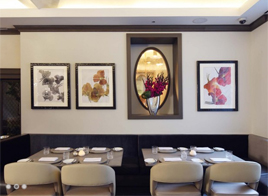
Note: Juni closed in May 2016. Neither the hotel nor the chef, Shaun Hergatt, explained the decision, but it is safe to say that the restaurant was not a hit. Despite a well-deserved Michelin star, Pete Wells of The Tiimes did not even bother to file a review. I don’t think Hergatt’s abilities as a chef can be seriously questioned, but there is limited demand for upscale dining at these prices, and Hergatt has now failed twice to make a dent in that market.
*
 You’ve got to give Shaun Hergatt credit for persistence, if naught else. His first fine-dining restaurant won two Michelin stars but took a critical drubbing. The critics acted like clowns, but the same clowns (or some of them) are still running the circus.
You’ve got to give Shaun Hergatt credit for persistence, if naught else. His first fine-dining restaurant won two Michelin stars but took a critical drubbing. The critics acted like clowns, but the same clowns (or some of them) are still running the circus.
A lot of chefs would have followed it up with a steakhouse or a noodle shop. But here he is again, giving the critics what they already told him they don’t want. To be fair, dumb reviews weren’t all that went wrong at SHO Shaun Hergatt. It was in a terrible location, not visible from the street, on an upper floor in a building surrounded with scaffolding and Jersey barriers. Even with the best reviews, I’m not sure he could have overcome that.
Juni (a diminutive of the Latin word for June) isn’t a SHO clone. It doesn’t look like a hotel in Dubai, the room isn’t as spacious or as opulent, there are no tablecloths, he’s not sending out edible gold leaf, and the wine list is far more modest. But it’s still an expensive fine-dining restaurant in a boutique hotel (The Chandler at 31st and Madison), a genre the foodocracy does not embrace.
There are two gracious, comfortable dining rooms, decorated in taupe and other muted colors, with custom flower prints on the walls and a large leafy centerpiece. The flower motif is in the food too, with colorful petals on many of the dishes. Servers are in navy suits and ties, runners in dark blue coats, with a low diner-to-staff ratio. There’s a heavy ceramic pedestal at every place setting, and plates are served on top of this. Water glasses, silverware, and serving pieces, etc., are first-rate.
The cuisine is recognizably Hergatt, but there is a hint of the new Nordic here and there, with a heavy dose of crisps, flower petals and herbs, assymetric platings, and austere presentation. Whether you like this style of cooking or not, it is obviously labor- and ingredient-intensive, and beautiful to look at.
There’s a bit of the “cult of the chef” in evidence: “The chef has selected…” “The chef has prepared…” “The chef recommends…” I don’t mind, but who are they trying to impress? Even at Per Se, they don’t do that. Just tell us what it is; we already know the chef selected it.
 The menu requires some explanation. Sixteen dishes without prices are arranged in five unlabeled categories. You eventually figure out which ones are appetizers, mains, etc., but it’s not spelled out. You can have four courses ($90), six ($120), or ten ($180). Only for the ten-course tasting are the dishes spelled out; for the others, you get to choose. For the others, I think there are rules (e.g., one course always has to be dessert), but I’m not sure exactly what combinations from the five categories are allowed.
The menu requires some explanation. Sixteen dishes without prices are arranged in five unlabeled categories. You eventually figure out which ones are appetizers, mains, etc., but it’s not spelled out. You can have four courses ($90), six ($120), or ten ($180). Only for the ten-course tasting are the dishes spelled out; for the others, you get to choose. For the others, I think there are rules (e.g., one course always has to be dessert), but I’m not sure exactly what combinations from the five categories are allowed.
On top of that, you can order à la carte: $20 for appetizers, $40 for mains, $15 for desserts. That’s too many options, and betrays some indecision on the chef’s part. In a year or two, I suspect some of those choices will disappear. The à la carte option feels like a sop for grazers, but I am not sure it’ll work: $40 feels too punishing a price for entrees.
But the prix fixes are not unfairly priced, assuming you like Hergatt’s cuisine. The four-course ($90), which also comes with amuses bouches and petits fours, is competitive with other restaurants in Juni’s peer group, or I should say intended peer group. Whether Hergatt can attract regular patronage at this tariff is the big question. He’ll have me as a supporter, but I supported SHO too, and look where that got him.
We ordered the six-course menu and asked the chef to choose.
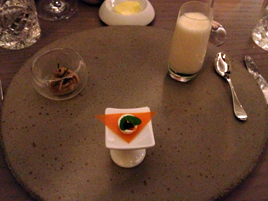
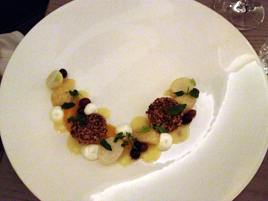
The bread service offered a green olive roll or a baguette, with soft Vermont butter and a green olive tapenade, served in a silver vessel. The amuses bouches (above left) included a carrot tuille with goat cheese; a parsip tapioca (the best of the three); and a pickled portobello mushroom fricassee.
For the first course, Wendy had the local fruit and nut platter (above right), which tasted a bit breakfast-y, but better than most breakfasts.
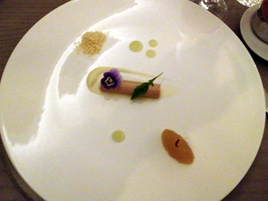
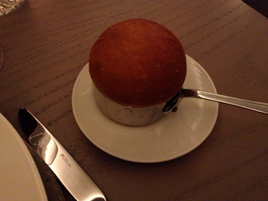
I started with the Hudson Valley foie gras (above left) with apple compote and almond dust, served with a puffy brioche (above right). This dish was technically well executed, but the minute portion size might offend some diners.
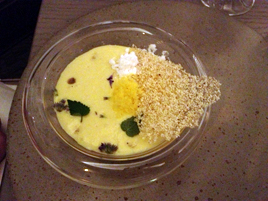
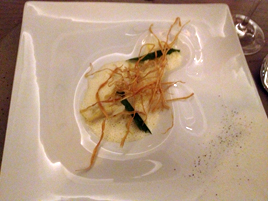
I was more impressed with the second course: farm egg poached with golden corn and salted popcorn (above left); black salsify agnolotti (above right) with salsify crisps and dandelion.

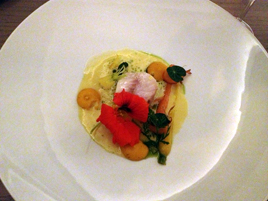
The fish course was wonderful: black bass, Yukon gold potatoes, flourless gnocchi, and truffle sabayon (above left); Montauk striper, tri-colored carrots, mint oil, and a sauce poured table-side (above right).
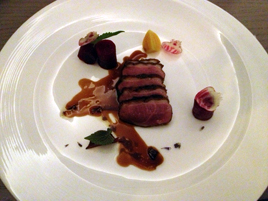

The two red meat courses were not at all the boring presentations that usually arrive at this point in a tasting menu. Duck (above left) was served with “beet cannons” and hibiscus jus, a luscious beef tenderloin (above right) with black truffle sauce and root vegetables.

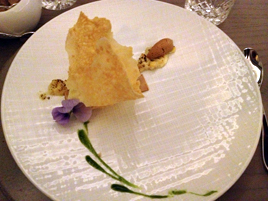
Photos don’t do justice to the desserts: grapes with walnut ice cream (above left), corn ice cream with corn tuille (above right).
 The petits fours (right) were far from the obvious stuff: beet chips, leaves dipped in chocolate and sugar, and a couple of other items I haven’t noted. Pastry chef Mina Pizarro is clearly trying to push the edge here, and the only question is if diners will go there with him.
The petits fours (right) were far from the obvious stuff: beet chips, leaves dipped in chocolate and sugar, and a couple of other items I haven’t noted. Pastry chef Mina Pizarro is clearly trying to push the edge here, and the only question is if diners will go there with him.
The chef recognized me (from multiple visits to SHO) and we were very well treated, although the only comp was a glass of dessert wine.
The dining room was full on a Wednesday evening, based on good early word-of-mouth and curiosity-seekers. The professional critics haven’t yet weighed in.
As I noted, Juni isn’t built for snacking. With coffee and a modest bottle of wine, our bill came to $320. I am a Hergatt supporter, and even I can’t do this very often. At these prices, regulars are harder to attract and keep.
I give Hergatt credit for doubling down on fine dining after his first experience. This is the kind of restaurant New York should have. Now we have to see if the critics and the dining public will agree.
Juni (12 East 31st Street near Madison Avenue, Kips Bay)
Food: American modernist with Nordic influences
Service: Elegant and refined
Ambiance: A quiet gracious dining room, elegant but not ostentatious
Rating: ★★★



Reader Comments